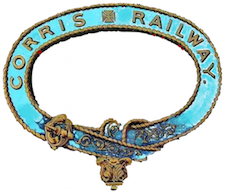
The Corris Railway is a narrow gauge preserved railway based in Corris on the border between Merionethshire and Montgomeryshire in Mid-Wales.

The River Taff is a river in Wales. It rises as two rivers in the Brecon Beacons; the Taf Fechan and the Taf Fawr before becoming one just north of Merthyr Tydfil. Its confluence with the River Severn estuary is in Cardiff.

The River Teifi in Wales forms the boundary for most of its length between the counties of Ceredigion and Carmarthenshire, and for the final 3 miles (4.8 km) of its total length of 76 miles (122 km), the boundary between Ceredigion and Pembrokeshire. Its estuary is northwest of Cardigan. Teifi has formerly been anglicised as "Tivy".

Pennal is a village and community on the A493 road in southern Gwynedd, Wales, on the north bank of the Afon Dyfi/River Dovey, near Machynlleth.

The Croesor Tramway was a Welsh, 2 ft narrow gauge railway line built to carry slate from the Croesor slate mines to Porthmadog. It was built in 1864 without an Act of Parliament and was operated using horse power.

Esgairgeiliog is a village in Powys, Wales, UK. It is situated at the junction of the Afon Glesyrch's and Afon Dulas' valleys.
Ratgoed quarry was the northernmost of the slate quarries served by the Corris Railway. It is one mile north of Aberllefenni in Gwynedd, Mid Wales, on the western side of Mynydd Llwydiarth. The quarry primarily worked the Narrow Vein, though it also produced some Broad Vein slates.

Sarn Helen refers to several stretches of Roman road in Wales. The 160-mile (260 km) route, which follows a meandering course through central Wales, connects Aberconwy in the north with Carmarthen in the west. Despite its length, academic debate continues as to the precise course of the Roman road. Many sections are now used by the modern road network while other parts are still traceable. However, there are sizeable stretches that have been lost and are unidentifiable.

The Afon Dulas, or North Dulas, is a river forming the border between Merionethshire/Gwynedd and Montgomeryshire/Powys in Wales. Another river called Afon Dulas joins the Dyfi from the south, upstream of its confluence with the North Dulas: locally this is referred to as the South Dulas.

Garneddwen is a hamlet in the south of the county of Gwynedd, Wales. It lies in the historic county of Merionethshire/Sir Feirionnydd, in the valley of the Afon Dulas.

The Afon Clun is a 14-mile (23 km) long tributary of the River Ely, in the counties of Cardiff and Rhondda Cynon Taf, Wales. Its bedrock is predominantly of sandstone. Beginning on the western slope of The Garth the river is fast-flowing, in clear shallow water with a hard substrate, flowing to the south of Llantrisant and generally west to its confluence with the River Ely at Pontyclun, falling 715 feet (218 m) over its course.

The Dyfi hills are a range situated in the southernmost area of Snowdonia, bounded by the River Dyfi on the east and south sides, by the Afon Dulas on the west and the Afon Cerist to the north. They lie to the west of the Aran Fawddwy range, north-east of the Tarren y Gesail range and are a subgroup of the Cadair Idris group.

The Ratgoed Tramway was a 2 ft 3 in gauge horse-worked tramway that connected the remote Ratgoed Quarry with the Corris Railway at Aberllefenni. It was 1.75 miles (2.82 km) long.

The Afon Dulas is a river in Powys, Wales. It is a headwater tributary of the River Severn, which it joins at Llanidloes opposite the confluence with the Afon Clywedog. Its principal tributary is the Afon Brochan. The total length of the Dulas and Brochan is 19.6 km. Other tributaries include Nant Cydros, the Rhydyclwydau Brook and Nant Gynwydd.

Mynydd Dolgoed or Craig Portas is a mountain in southern Snowdonia, Wales. It is a long ridge running from a low summit between the valleys of the Afon Angell and the Nant Ceiswyn, north east to the cliff of Craig Portas above Dinas Mawddwy. The next mountain in the ridge to south-east is Mynydd Hendre-ddu, while to the south lie Mynydd Llwydiarth and Mynydd Cymerau.

The Afon Deri is a river in Mid Wales. It flows from the eastern flank of Mynydd Ty-Glas down to Corris, where it joins the Afon Dulas that flows south to the Afon Dyfi.

Cymerau quarry was a slate quarry served by the Ratgoed Tramway, a horse-worked section of the Corris Railway. It is located about half a mile north of Aberllefenni in Merioneth, North Wales, on the eastern side of the isolated Cwm Ceiswyn. It worked the Narrow Vein, the highest-quality slate vein in the Abercorris Group.

The Nant Llwydiarth is a small river in Mid Wales. It flows from the southern flank of Mynydd Hendre-ddu down to Pont Cymerau, north-east of Aberllefenni. Here it joins the Nant Ceiswyn to form the Afon Dulas that flows south to the Afon Dyfi. There was an ancient bridge at Pont Cymerau.

Cwm Hengae is a valley that runs roughly north-west from the village of Aberllefenni in Wales. The Afon Llefenni river runs along the valley and several slate quarries occupy the valley sides. The Roman road Sarn Helen ran along the valley, connecting Aberllefenni with Dolgellau.

The Narrow Vein Mudstone Formation is an Ordovician lithostratigraphic group in Mid Wales. The rock of the formation is silty, homogeneous or finely-laminated mudstone. It generally a medium blue colour. This formation has been commercially quarried as slate in several locations along its length. The formation is between 400 metres (1,300 ft) and 560 metres (1,840 ft) thick and runs from Dinas Mawddwy south-west to Cardigan Bay at Tywyn.




















